Week 48: Genoese Sponge |
Story location: Home / food_and_drink / recipe_a_week / |
| 27/Nov/2013 |
I've made ordinary sponge cakes before but this is the first time I've tried making a Genoese Sponge, where beaten eggs are used instead of baking powder to rise the sponge. I've felt that I should try making one since it's probably another cake method I should add to my repertoire.
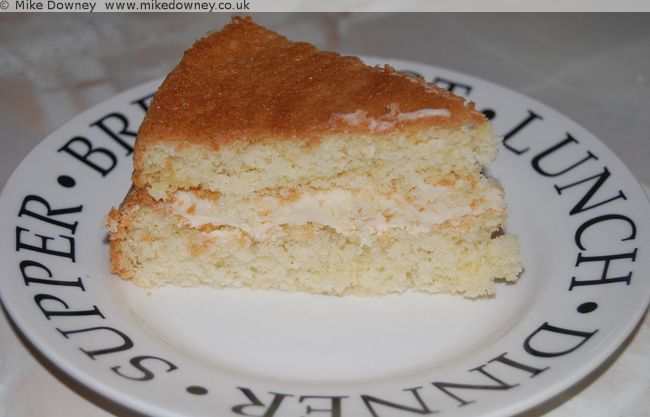
The recipe I used came from the River Cottage Cakes Handbook. It started with 125g of caster sugar and 4 eggs and these were beaten with an electric whisk in a bain marie until they had trebled in size. 125g of sifted flour was then folded in, followed by 75g of cooled melted butter.
The cake was baked for 25-35 minutes at gas mark 4 (the top layer was thinner and cooked faster). I think I should have reduced the cooking time because the cake had a slightly crunchy edge to it but, when eaten with the buttercream, it all went together well.
The Christmas Lights were switched on in the city centre tonight. Unlike previous years, when they have had celebrity musicians present (such as Roy Wood last year and The Hoosiers a couple of years before that), this year the council tried to save a bit of money and had some local bands performing instead. As usual, the festivities took place in Broadgate.

Week 47: Polish Mazurka Cake |
Story location: Home / food_and_drink / recipe_a_week / |
| 21/Nov/2013 |
I think most people agree that the crumble topping is the best part of a fruit crumble, so a cake which is mostly crumble should be very good. My interpretation was based on two recipes but as usual I made a few changes.
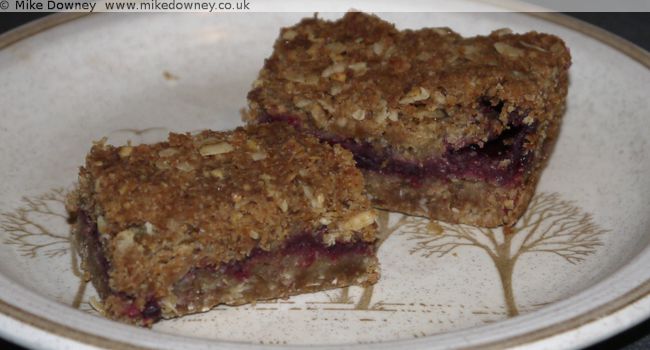
To make the crumble mixture, I put the flour, brown sugar and butter in a food processor and blitzed until they formed breadcrumbs. I then mixed in some ground almonds and dessicated coconut.
The fruit layer was made using a tub of berries from the bushes in our garden. This was a mixture of blackberries, blackcurrants, gooseberries and alpine strawberries. I put them in a pan with a tablespoon of water and slowly heated them to a simmer. I then added a couple of tablespoons of sloe gin mixed with cornflour and stirred this in until the fruit mixture had thickened.
I put half of the crumble layer in the bottom of a lined 8 inch tin and pressed it down. I then spread the fruit layer and finally topped with the rest of the crumble. The tin then went into the oven (gas mark 4) for about 45 minutes or so, until the top looked cooked.
I left the cake (or is it a biscuit?) to cool before slicing it and removing it from the tin.
I think that fruit crumbles work best when the fruit has a slightly sharp taste. This is probably why one of the most popular uses of rhubarb is in a crumble. Since my fruit mixture contained alpine strawberries and gooseberries (and no added sugar apart from the small amount in the sloe gin), the fruit layer had a good amount of sharpness to balance the sweetness of the crumble layer.
It's very hard to eat just one.
I do like a nice cup of coffee and in my last job I would regularly get a latte from the canteen and several filter coffees per day from the communal kitchen in the department. Since I'm not working at the moment, I thought I would investigate some of the coffee shops in the city centre, concentrating on independents and avoiding the big chains.
I sometimes go to Ikea where I can get a free drink using my 'family card'. I often buy a cake or a bar of chocolate (or if I am there during breakfast, a bacon sandwich) and sit and relax for half an hour or so but the coffee is fairly unremarkable and not really strong enough for my liking.
I occasionally walk down Far Gosford Street and most of the time I find myself popping into Windsor's for a take-away coffee. I usually choose either the americano or a latte. They are good value at under £2 and actually taste of coffee. The shop is run by a local charity (The Coventry Cyrenians) who provide assistance to unemployed or homeless people.
For many years I would avoid drinking coffee in cafés because it was rare to get a drinkable cup. Filter coffee would always be too weak and espresso machines weren't very common back then. I would choose a cup of tea instead. These days it is much easier to get a good cup of coffee, although a bad cup of coffee is still fairly common. There are some good independent coffee shops out there, such as Windsor's, and I'll try to make an effort to explore a few of them.
Week 46: Porridge Cake and Cauliflower Pizza |
Story location: Home / food_and_drink / recipe_a_week / |
| 12/Nov/2013 |
Now that we are approaching winter, I have started making porridge for breakfast. My usual approach is to put 1 cup of oats in a jug, add any dried fruit or other flavours (such as flaked almonds or shredded coconut), followed by 1½ cups of milk. I then leave this in the fridge overnight, ready to cook in the morning.
The porridge takes about 3 minutes to cook in the microwave. I don't add any sugar but I sometimes add a bit of honey.
I had spare porridge left over today (dried mango and coconut flavour). I thought I'd have a go at making a cake from it, following the same idea as the rice pudding cake. I had some 'cereal dust' from the bottom of a couple of boxes of cereal so I put that in too.
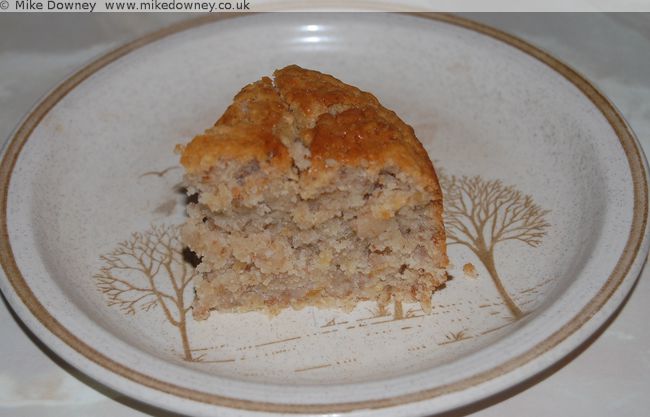
The end result was surprisingly similar to the rice pudding cake, with a moist, chewy and cakey texture. It's a good way of using up leftover porridge.
The second recipe this week was a Cauliflower Pizza. My version was topped with bacon, black pudding, baked beans and cheese (using up some kitchen leftovers). I used half a cauliflower to make the base and I didn't really measure anything, I just mixed it together until it looked right.
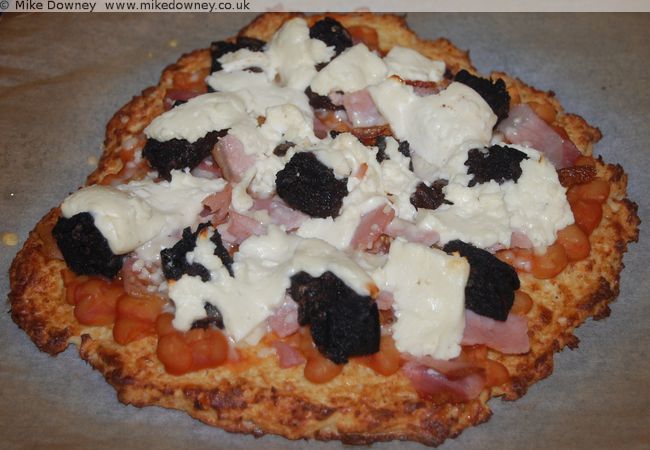
Making the base was a bit long-winded because our food processor is a bit small and it took several batches to break up the cauliflower and grate the cheese. This is a novel way of serving cauli, a bit more original than cauliflower cheese (which I do like - that's how I'll probably eat the other half).
Week 45: Yet more cake |
Story location: Home / food_and_drink / recipe_a_week / |
| 07/Nov/2013 |
It's probably wrong to make a cake only a few days after making baklava, when we still haven't finished eating it yet. I bought a couple of nets of tangerines which had been reduced to 20p because some had got a bit squashed. I took the damaged ones, put them in the food processor and used them to make Mary Berry's Spiced whole orange cake. We saw her make this cake at the Good Food Show in the summer and now was my chance to make it.
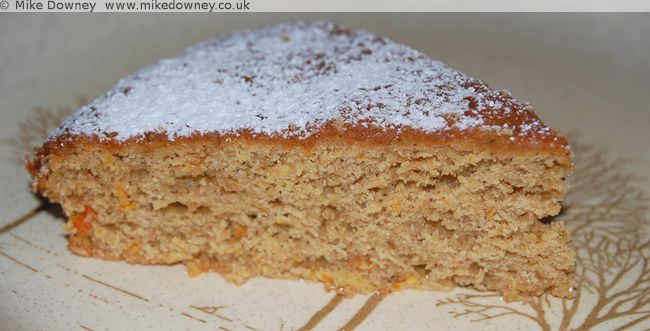
I used 3 tangerines and only made a single layer. I halved the ingredients apart from the spices, since we always believe that cakes need more cinnamon than most recipes suggest. Sadly our food processor is only a tiny one so I had to make the cake by hand, blending the butter and sugar together before adding the rest of the ingredients.
Since Mary Berry is one of the judges on the Great British Bake-Off, you'd expect good things from her cake recipes. I certainly wasn't disappointed with this. If I was making this cake for more people (not just the 2 of us), I'd do it properly with the orange buttercream filling, but even without it the cake was very good.
Week 45: Pistachio and Date Baklava |
Story location: Home / food_and_drink / recipe_a_week / |
| 03/Nov/2013 |
I seem to be making a lot of things based on recipes from the Hairy Biker's books but that's probably because a) they are quite good books and b) I got 3 of them this year. This week's recipe is one I've been meaning to make for a while and is based on a recipe from their Pies book.
We both like baklava but don't eat it often because it is usually quite expensive to buy. They can be a bit labour intensive to make but they weren't very difficult. The main problem was handling the filo pastry without it falling apart.
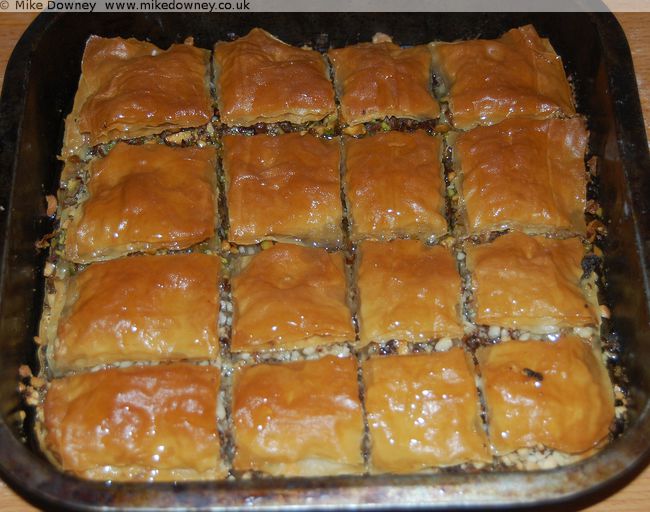
I made the filling with chopped mixed nuts, chopped pistachios and chopped dates. I cut squares of filo pastry to fit the tin then brushed the tin with melted butter. I brushed a square with melted butter, put another square on top and repeated until I had a stack of 5. I put these in the bottom of the pan, and them topped with a third of the filling.
I put a square of filo on top, brushed it with butter then a second square. I then repeated with another third of the filling and 2 more sheets of pastry and the final third of the filling.
The remaining sheets of filo were brushed with butter and stacked then put on top. I scored the top with a knife, to divide the baklava into 16 pieces. I baked it in the oven for about half an hour until the top looked crispy.
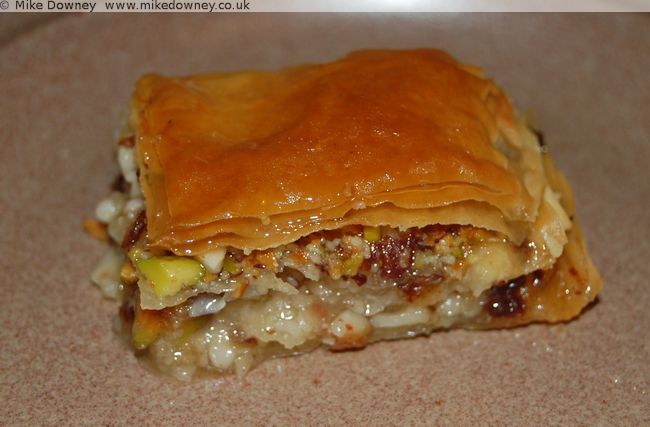
I made a syrup using 100ml of juice from a tin of fruit, 200g of sugar and 2 tablespoons of lemon juice. After the baklava had cooled a bit I spooned the syrup over the top, pouring most of it down the score marks.
After a few weeks of cakes which have been ok but not spectacular, the baklava was a total success, tasting every bit as good as bought ones.
